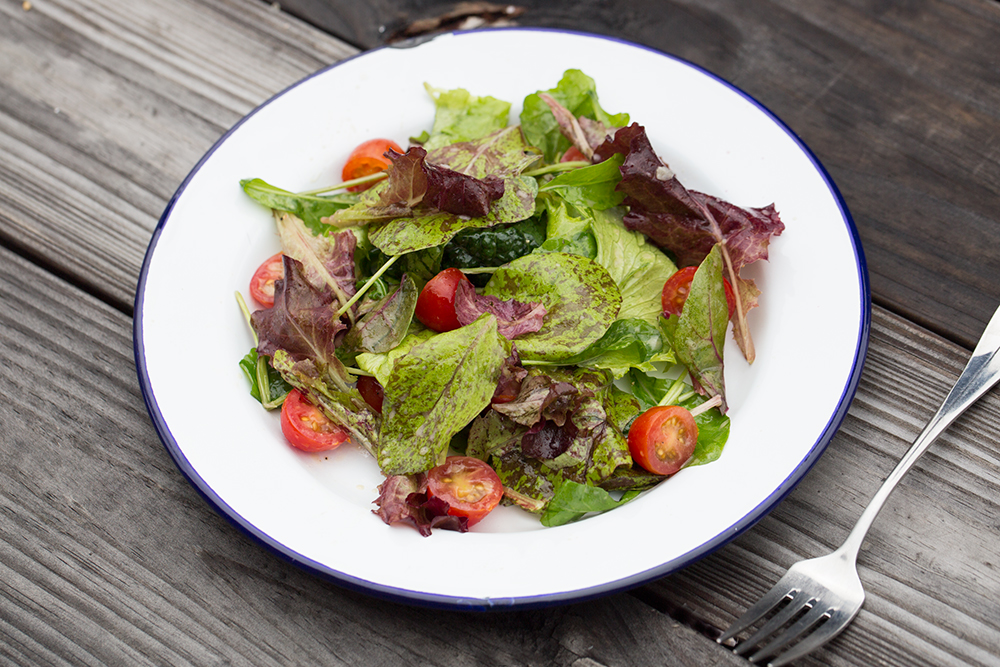
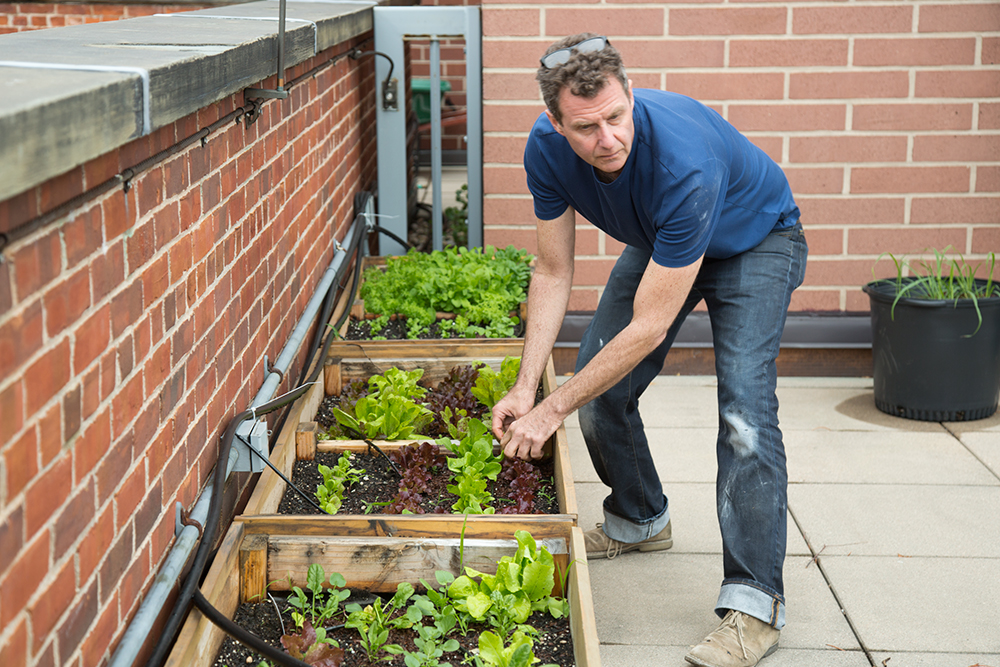
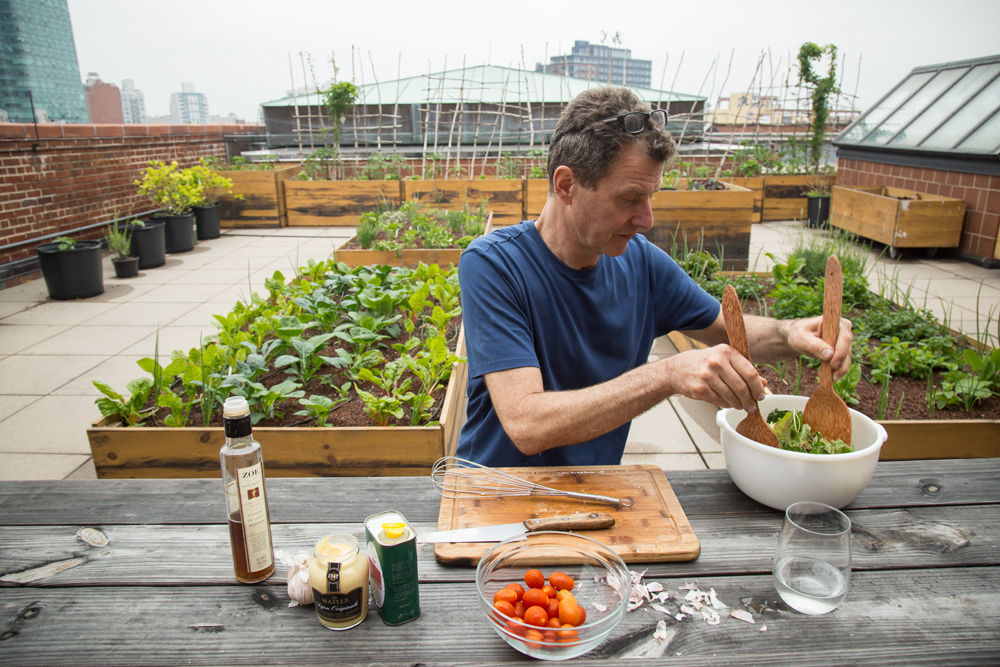
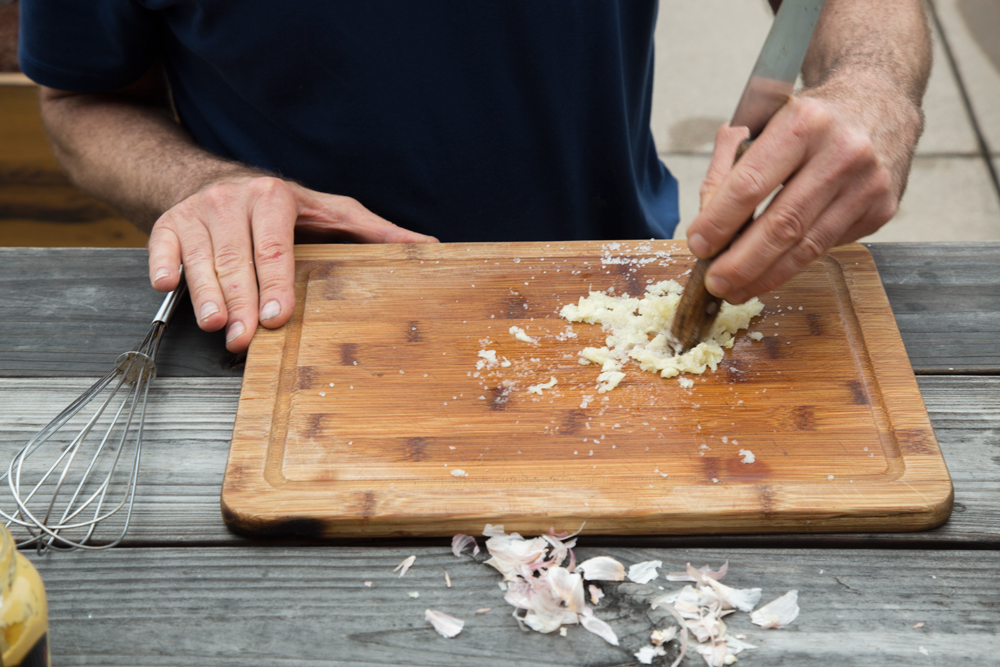
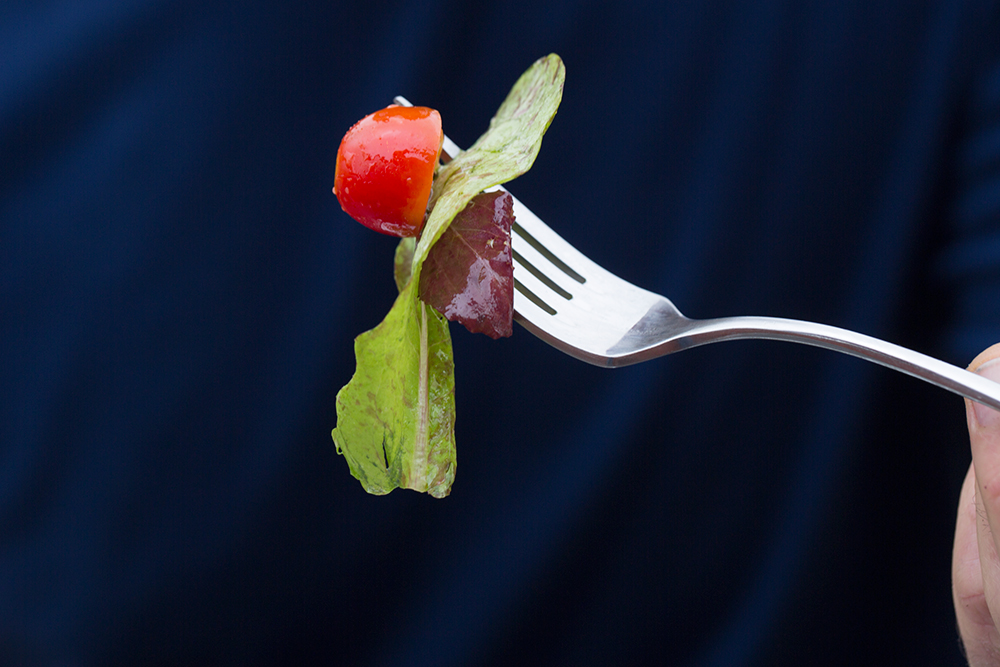
INGREDIENTS
- arugula,
- garlic,
- gem lettuce,
- Merlot Lettuce,
- mustard,
- olive oil,
- Sherry vinegar,
- tomatoes
RECIPE
DIFFICULTY
EASY
SERVES
2
PREP TIME
5 MINS
Salad
-
1lbsalad greens, we used speckled gem lettuce, arugula, red merlot lettuce and cress
-
1cupcherry tomatoes
Dressing
-
1tsppeeled garlic cloves
-
1tsprock salt
-
1tbsDijon Mustard
-
1tbsSherry vinegar
-
3-4tbshigh quality extra virgin olive oil
INGREDIENTS
- arugula,
- garlic,
- gem lettuce,
- Merlot Lettuce,
- mustard,
- olive oil,
- Sherry vinegar,
- tomatoes
I am thrilled to post my first artist-made salad from the MoMA PS1 Salad Garden that I have been toiling away at for the last two months.
My first piece of advice: do not look at a day in the life of Jon Kessler if you want to feel productive or accomplished yourself. No matter who you are.
Jon is a famously beloved professor at Columbia University Visual Arts program, he has exhibited his kinetic sculptures and massive installations worldwide since the mid 1980s, he is a father, the husband to the brilliant author Asti Hustvedt, and a member of two bands. He himself is always a student, taking risks with his work and dedicating much of his time to inspiring others to never get too comfortable. Jon is someone I turn to when I am looking for some truth (I am not sure he knows how to deliver much else), and I was honored to spend a few hours of his precious time making a salad, talking about the life of an artist, learning to paint, and the prospect of old age with an ocean view.
Jon Kessler in His Own Words
JON KESSLER ON ELI ZABAR, MUSIC AND COOKING AS LITMUS TEST
Jon: This salad is really simple, and best made with freshly picked tomatoes. I know the tomatoes in the garden aren’t ready yet, so I brought some from the store. The greens are perfect though. This recipe is courtesy of Eli Zabar.
Julia: Is there a Zabar’s cookbook?
Jon: No, he’s a friend. He taught this to me himself.
Julia: Really?! That is a great New York celebrity to have has a friend.
JK: Last summer, Asti [Jon’s wife, author, and upcoming guest salad chef] and I had a residency at the Dora Maar house. The house is located in a small town in the South of France called Minèrbes, and Eli Zabar owns a house in the same town. Going to the market with Eli in the South of France is a fucking trip. He goes there to source products for his New York stores: The Vinegar Factory, or Zabar’s. He is not there to taste, he is figuring out what to import. Going to these markets could potentially be really overwhelming, but he knows all the best vendors — where to get the best apricots, the best cherry preserves…
J: Do you cook often?
JK: I like to cook, but Asti does most of the cooking and I do more of the grilling. I am a good cook, but we don’t work the same way in the kitchen. As a rule, I do not use cookbooks, and Asti is so diligent with a recipe, her cookbooks are filled with corrections and modifications to the measurements, notes in the margins…
J: I wish sometimes that I were that way, but I am not.
JK: Me neither. I can’t help it; I need to create without rules. There are certain things I have never been good at, even as a child (I am pretty sure I had ADD): I hated board games, puzzles, all the things that the other kids would do. Instead, I was building tree houses and putting things together; I craved individualized, creative play. Even now, I am in two bands, one with [artist] Jon Miller and the other with [artist] Robert Longo. I refuse to perform a cover song, unless we fucking transform it to the point where it is unrecognizable. I don’t want to play someone else’s music.
J: Have you ever enjoyed playing someone else’s music?
JK: No, I came out of the traditions of improv, jazz and jam bands. I am continually amazed at the impact that my upbringing of smoking dope and playing with jam bands has had on the way I make my art. It is the same reason why I just don’t like to follow recipes in the kitchen. I like to taste, see what something needs, make a decision that might not follow the prescribed rules.
J: When I am not in studio, I am cooking, and finding other more immediate ways to collaborate and share the things I make. Is this how music functions for you?
JK: Music is a big part of the overage, the surplus of my artistic energy. I used to work in a manic way – pull all nighters, do drugs. That changed when I had my daughter. I love coming home at 7pm and having dinner with my family, but that still leaves me hours to fill later in the evening. These days, I have a habit of drawing in the evening, while Asti reads. Maybe after watching an episode of The Good Wife.
JON KESSLER ON TEACHING, PAINTING AND MOVING TO TRINIDAD
J: Do you feel like a father figure to your students? Like you gave birth to us all?
JK: When I go to a big art opening and all of my former students are all around, I feel like I am part of a really big family. If a student reaches out, then I reach back. Being in the art world is really about being part of a network of people, and that network gives you strength.
J: When I think about the lecture you gave my first night as a student at Columbia, the message that sticks with me was, as a good artist, one never “figures it out.” Success is not a cure for self-doubt, but it can drive you to keep going.
JK: I am honest about the ebbs and flows about a career and creative juices. If anything, and I have learned this from my own teachers, you have to be honest with students. And, there comes a point where you have say, “I have to go home now, I have a life.”
J: What do you love about teaching?
JK: I love to get to know people. You don’t get anything out of teaching if you don’t put a lot into it. In the last couple years, I started to paint. That is a direct result of being in Graduate students’ studios. I have been painting everything: still lives, landscapes, figurative work, abstraction. I am spending time in the material.
J: That is amazing, and unexpected; quite a radical departure from kinetic sculptures, and chaotic installations.
JK: It is amazing. I spent my whole residency at the Dora Maar House (where I met Eli Zabar), painting. It was a gorgeous studio with incredible light. Every day, I would just open the windows and paint the landscape.
J: Does it make you nervous to make such a drastic shift in your studio practice at this point in your career?
JK: Yes and no. I am not prone to that kind of anxiety, I have already walked off the cliff. I am in freefall. So yes, I could be nervous, or I could see this as, “Wow, maybe late in life I will be living in Trinidad, just doing hot yoga 4 times a week, and painting landscapes.”
J: Do you think you could really do that?
JK: Yes, I do. At this point in my life, I am really well-known for making one kind of work, but that is how you know you gotta fuck it up.
J: Would you be lonely? Going from a very social New York, to an island lifestyle?
JK: While Asti and I were in the South of France, we were away from friends and family, and it was great. We met new people, made friends. I think that loneliness will be even less important as I get older.
J: Then what are you waiting for?
JK: Good question… Asti is not ready to move to Trinidad, yet. But, I don’t want to be an old person in New York. I want to build myself a really great place to spend my old age, while my body is still capable. That could be in India, or Africa, somewhere on the beach. So right now, that’s my goal. I can imagine, 20 years down the road, when I am no longer compelled by the physicality of my large installations, I will want to commune with a painting that is right there in front of me.
J: Jon! That is really romantic! You sound so at peace with that, I am jealous.
JK: Yeah it is really fun.
J: Have you shown anyone your paintings?
JK: I have only shown the paintings to my students, again, to show them the value of being an amateur, and the value of putting your ass on the line.
J: That is what makes a good artist. Taking risks. Now show me your paintings.
JK: (Smiles)